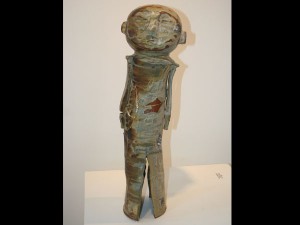
Bulol, means mute. The artist derives inspiration from bulol’s essence of quietude, and happily yields to its energy guiding him to create the basic forms, leaving the potter’s hands reaching out to his native Philippine origin.
“If you look at all the pictures of bulol, the gesture of its face is minimal, its marks are minimal. You can’t tell what’s going on, from its shape, from the proportion of its head and body. For me, studying the faces of bulol has given me a good feeling,” explains Mendoza. The god symbolizes a positive energy in all things.
Making bulol in its traditional form means using very simple technique and minimal approach in making its eyes and nose. There were very subtle changes, but nothing radical. The artist is careful not to disrespect it.
“The feeling and emotion that you get from the minimal gestures that created bulol is a strong one. Its basic forms and basic emotions represent dull, muted, and subtle hope, but, more importantly, they are about a belief or confidence that something will come out. It’s a strong sculptural inspiration,” he assesses.
Indeed, his meditation on bulol has tempered an expressionistic style. It has made him unusually satisfied in shaping the fundamental nature of a “subtle breakthrough” on clay. In order to make his work take on an organic look, he tweaked the recipe of his new found clay: 70 percent ball clay and kaolin, 20 percent feldspar, and 10 percent silica.
He wanted the coarsest and chunkiest red clay with lots of iron, he researched until he found the quality of clay he was looking for. “It looked gritty and unrefined, like the clay of Quezon province that I used in the Philippines,” the artist recalls.
His restless spirit moves on to enhance that quality that he was once comfortable with.


